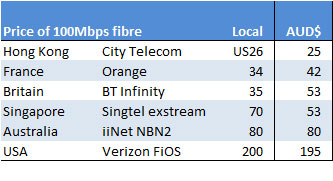By the numbers: fast, cheap and subsidy free

When scanning the globe to see what country is offering the best, fastest and cheapest fibre broadband plans, it looks like you can't go past Hong Kong. Could competition deliver the same value in our major cities?
City Telecom's Hong Kong Broadband Network now boasts 1Gbps broadband speeds with unlimited downloads, priced at just US$26 per month. A few months ago, it had more than 600,000 subscribers connected at speeds of over 100Mbps. And it did it without any government subsidy. By comparison, here in Australia, iiNet is selling 100Mbps on the government-funded NBN, with download limits, for almost three times the price ($80).
Of course, Hong Kong has lots of people crammed into a small area — 6480 people per square kilometre, three times the density of Sydney and four times that of Melbourne.
The UK (where high-rise living isn't common) provides another interesting comparison. Over there, BT was structurally separated, and their network division has been rolling out fibre with some government subsidy. Both BT and Virgin are offering fibre connections at 100Mbps for £35 ($53). Adjusted for purchase power parity (to reflect the cost of living), it works out that we're still paying well over what the poms pay.
Not only are we expensive, we're also slow to get it. Years of protestations about who will build the infrastructure has also slowed us down. Meanwhile, in North America, almost 8 million homes are already connected to fibre, with 22 million homes passed. Prices are high for the vanilla service, but TV bundles for not much more are almost certainly helping uptake. We convinced ourselves that we were front runners on fibre a few years ago, but we were all talk. Now, it seems, we're quickly slipping behind the rest of the world.
This table shows the best prices that we found (you might do better) from major providers in various countries around the world. Whichever way you look at it, the NBN is providing an expensive solution. The US is the most expensive, except when we look at lower speeds — you still pay a premium for higher speeds over there.

(Credit: Phil Dobbie/ZDNet Australia)
What makes Australia unique, of course, is our attempt to drive fibre out to 93 per cent of the country. It's a noble aim, but it comes at a cost, with the cross subsidisation of those regional areas pushing up prices to major metropolitan areas. International comparisons seem to suggest that the level of that cross subsidisation could be extremely high.
The alternative approach is to allow competitive build in metropolitan areas, and only subsidise areas that are not contestable. We'd hope that would get fibre prices in our cities to something comparable with the rest of the world. To achieve the same price outside the cities would mean a far higher level of subsidy, of course, but at least the price would be transparent. The argument would switch from "Do we need an NBN?" to "Do we need an NBN everywhere?"
Instead, we seem to be aiming for a uniform pricing across Australia. If the argument is that the NBN will make us internationally competitive, shouldn't we be aiming for prices that match the rest of the world, at least in some parts of Australia?
Updated at 2:57pm, 9 January 2012: corrected the price for iiNet's NBN plans (thanks Paranoid) and removed reference to Bell Canada's 100Mbps plan, given the company's fastest plan is 30Mbps (thanks sjl and Catherine).